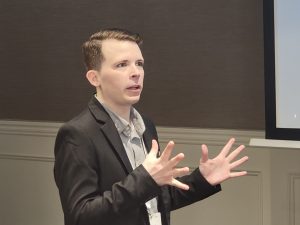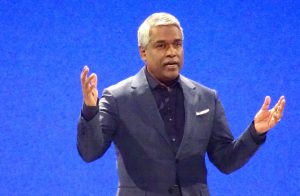Data as the Common Language: CEO Series with MuleSoft’s Greg Schott
![]() The world has seen a huge shift in the way software is created and utilized. No longer does a company need an in-house team devoted to building software–an entire industry has emerged around SaaS, offering turnkey solutions that address a growing pool of very specific problems. Indeed, there is an app for that, even in the enterprise world. But what’s still lacking is an easy way to stitch these apps together, helping them work together towards a common goal.
The world has seen a huge shift in the way software is created and utilized. No longer does a company need an in-house team devoted to building software–an entire industry has emerged around SaaS, offering turnkey solutions that address a growing pool of very specific problems. Indeed, there is an app for that, even in the enterprise world. But what’s still lacking is an easy way to stitch these apps together, helping them work together towards a common goal.
MuleSoft has set out to make software play nicely together, so a company can still get by without an in-house team devoted to managing software connectors. Building a business in the integration space, MuleSoft wants to connect applications as easily as Facebook connects people, eliminating the pain and cost of custom point-to-point integration on-premise and in the cloud.
Today we hear from MuleSoft president and CEO Greg Schott, who shares his thoughts on data becoming a common language for apps, the benefits of a cross-discipline approach in business, and his dream collaboration.
![]()
![]()
See the entire CEO Series with Kristen Nicole on Pinterest and Springpad!
.
How is data creating a common language for apps?
Public APIs and REST have created a common language for apps. Until recently, connecting apps always required a large investment in services work. Now, APIs have dramatically risen in importance, to the point that when most developers build applications, the API is often where they start.
With the rise of the API, the value is in the integration itself: the business logic between apps rather than the connectivity to them. Connectivity to apps is becoming a commodity, and it shows up in the MuleSoft pricing model – unlike other cloud integration providers, we do not price integration on a “per connector” basis.
What’s the most unique connector MuleSoft’s built for a client?
![]() Mule, the open source integration platform, is used across a variety of industries and use cases. Formula One uses Mule in F1 cars to integrate with on-board car telemetry systems. At 200 miles an hour, these machines are generating massive amounts of data both to optimize performance and to maintain the safety of the driver. You can imagine that getting this data to the pit teams at the right place at the right time is critical.
Mule, the open source integration platform, is used across a variety of industries and use cases. Formula One uses Mule in F1 cars to integrate with on-board car telemetry systems. At 200 miles an hour, these machines are generating massive amounts of data both to optimize performance and to maintain the safety of the driver. You can imagine that getting this data to the pit teams at the right place at the right time is critical.
Similar to the apps and databases your company has to unify, in a sense, you’ve also applied a diverse background in engineering, marketing and management to your work. How has this helped you transition MuleSoft since you took on the role of CEO in 2009?
Building a successful company in such a dynamic and competitive industry requires that a company fires on all cylinders – across engineering, marketing, sales, services and operations. My cross-functional background has helped me have context to understand the gaps and opportunities across the company and to successfully build the processes and teams we needed in those areas.
In most everything I do, I tend to live by the mantra, “quality over quantity.” That seems a fitting principle for facing today’s massive integration problem, especially when it comes to improvING data flow instead of building a bigger data system. What’s the most important way data systems can get smarter?
I see this problem like a supply chain. Car companies and then electronics companies became “smarter” by building and coordinating an ecosystem of suppliers with specific core competencies. This will follow for applications. It’s not going to be how to build a bigger monolith, but rather, how to coordinate internal and SaaS applications to create a smarter, more responsive enterprise.
In fact, there are entire companies being built on this emerging model. One of our partners, Avalara, is a SaaS-based tax automation engine. It’s a critical function that shows up in literally every single commercial transaction, yet it would make no sense for every company to build its own tax engine. That’s what makes Avalara such an interesting partner for MuleSoft. On its own and isolated from other applications, tax calculation is not that interesting. But integrated with order management, billing engines, invoicing and financial applications, suddenly Avalara is driving critical value in the business process. The beauty of this new SaaS model is rather than adopting and maintaining an on-premise financial suite, customers can now choose the best solution for each piece of the value chain and integrate those applications and solutions together to create a unified business process that reflects its unique competitive differentiation.
You mentioned you got into this industry because you were excited about the prospect of bringing open source and the cloud together. What gives you confidence in the future?
First, I can’t think of a time in our industry when so much change and opportunity has occurred in such a short time frame. Bringing the power of open source and the shift to the cloud together just feels right at this point in time. Second, everywhere we go, our enterprise customers and SaaS partners lament the challenge that integration is creating for them. The integration problem is only becoming larger with the growing number of SaaS applications. MuleSoft is the right solution for solving the huge $500B integration problem.
![]()
GREG SCHOTT
COMMON DENOMINATOR
What language would you like to learn?
Spanish.
Most satisfying project (career or personal)?
Building a company that’s making a huge impact in technology.
What’s your dream collaboration (person or company)?
Create a unified Electronic Health Record by collaborating with the NIH, Medicare, patients, insurance and health care providers.
A message from John Furrier, co-founder of SiliconANGLE:
Your vote of support is important to us and it helps us keep the content FREE.
One click below supports our mission to provide free, deep, and relevant content.
Join our community on YouTube
Join the community that includes more than 15,000 #CubeAlumni experts, including Amazon.com CEO Andy Jassy, Dell Technologies founder and CEO Michael Dell, Intel CEO Pat Gelsinger, and many more luminaries and experts.
THANK YOU












